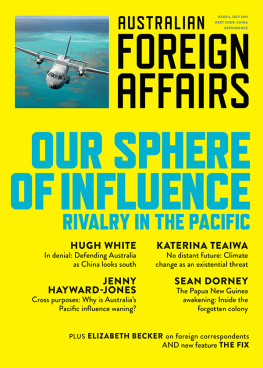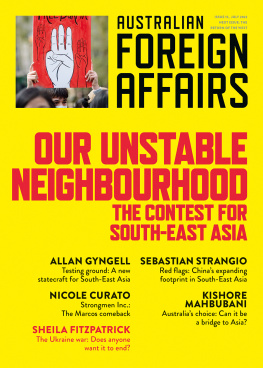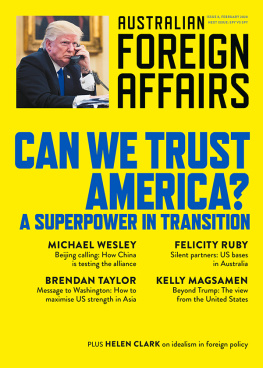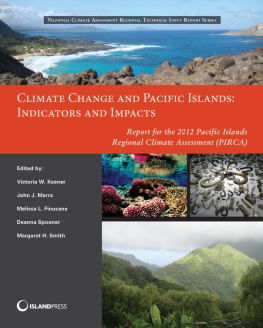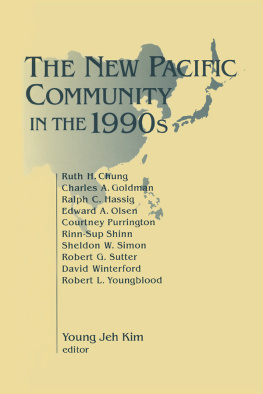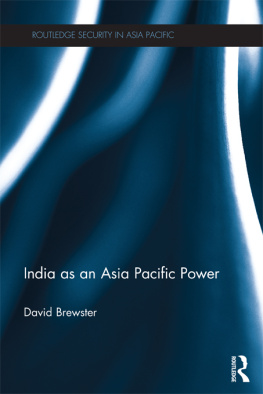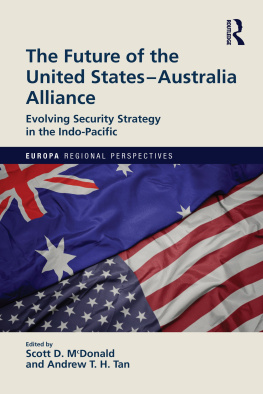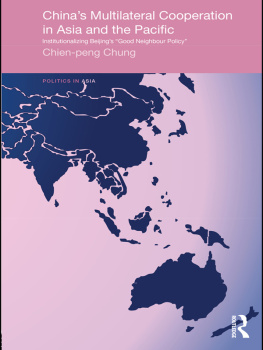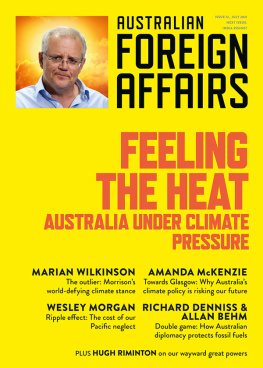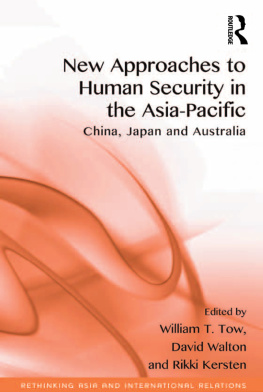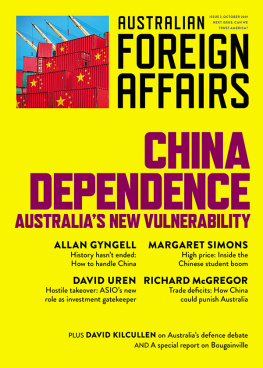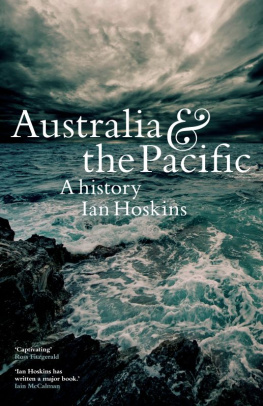ISSUE 6, JULY 2019
AUSTRALIAN FOREIGN AFFAIRS
Australian Foreign Affairs is published three times a year by Schwartz Publishing Pty Ltd. Publisher: Morry Schwartz. ISBN 978-1-74382-0940 ISSN 2208- 5912 ALL RIGHTS RESERVED. No part of this publication may be reproduced, stored in a retrieval system, or transmitted in any form by any means, electronic, mechanical, photocopying, recording or otherwise, without the prior consent of the publishers. Essays, reviews and correspondence retained by the authors. Subscriptions 1 year print & digital auto- renew (3 issues): $49.99 within Australia incl. GST. 1 year print and digital subscription (3 issues): $59.99 within Australia incl. GST. 2 year print & digital (6 issues): $114.99 within Australia incl. GST. 1 year digital only auto-renew: $29.99. Payment may be made by MasterCard, Visa or Amex, or by cheque made out to Schwartz Publishing Pty Ltd. Payment includes postage and handling. To subscribe, fill out the form inside this issue, subscribe online at Editor: Jonathan Pearlman. Associate Editor: Chris Feik. Consulting Editor: Allan Gyngell. Deputy Editor: Julia Carlomagno. AFA Weekly Editor: Dion Kagan. Management: Caitlin Yates. Marketing: Elisabeth Young, Georgia Mill and Iryna Byelyayeva. Publicity: Anna Lensky. Design: Peter Long. Production Coordination: Marilyn de Castro. Typesetting: Akiko Chan. Cover photo of aircraft by Olivier Ravenel/Arme de lair/Armes.
Contributors
Elizabeth Becker is a former New York Times correspondent and the author of When the War Was Over.
Alison Broinowski is a former Australian diplomat and academic.
Sean Dorney is a Walkley Awardwinning journalist and a nonresident fellow at the Lowy Institute.
Bill Farmer was Australian ambassador to Indonesia from 2005 to 2010.
Euan Graham is executive director of La Trobe Asia and former director of the international security program at the Lowy Institute.
Jenny Hayward-Jones is a nonresident fellow at the Lowy Institute.
Robert E. Kelly is a professor of international relations at Pusan National University in South Korea.
Kayleigh Long is a journalist who worked in Myanmar between 2013 and 2018 and is now based in London.
Katerina Teaiwa is an associate professor in the School of Culture, History and Language at the Australian National University.
Hugh White is a professor of strategic studies at the Australian National University and a former deputy secretary in the defence department.
Editors Note
OUR SPHERE OF INFLUENCE
O n 2 June 2019, Scott Morrison landed at Honiara International Airport in Solomon Islands for his first overseas visit since winning the federal election. This airport, on the northern coast of the island of Guadalcanal, was built in 1942 by Japanese troops as they tried to cut off supply lines between Australia and the United States, potentially allowing for an invasion of Australia. US troops eventually captured the airfield in a battle that marked the beginning of the Allied victory in the Pacific.
In April 2014, the airport was left underwater following the worst recorded flooding in the countrys history. At least twenty-three people were killed and 50,000 were affected as the deluge 73 centimetres of rain in three days caused mudslides that destroyed villages, roads and livelihoods. The next year, Solomon Islands prime minister Manasseh Sogavare addressed the United Nations and declared that the threat of climate change to his country was existential.
When Morrison arrived at Honiara, he was not there to discuss climate change. His concern, shaped by the legacy of World War II, was to prevent Solomon Islands again becoming a staging point for an attack on Australia. This is the unstated motivation for the Pacific step-up, his signature foreign policy to ensure that a foreign military presence is not installed in Australias sphere of influence in the South Pacific. Today, this threat comes from China.
But this longstanding goal of Australian defence and foreign policy is now being challenged. Chinese aid and influence are spreading southward, just as Australias diplomatic clout in the Pacific is coming under strain. Solomon Islands, whose largest trading partner is China, has recently signalled it may shift its diplomatic allegiance from Taiwan to China. And countries such as Papua New Guinea a former Australian colony are welcoming an increasing flow of Chinese funds. The prospect of a nearby Chinese military base is causing anxiety in Canberra, but Australia is still the largest Pacific donor, and presumes that recipients will see it as both a benefactor and a protector.
As part of his step-up, in 2018 Morrison visited Fiji and Vanuatu, the first diplomatic trip to either country by an Australian leader. This renewed Australian interest has been largely well received by Pacific states. The problem is that Australia and its neighbours currently view these two world-changing phenomena, Chinas rise and climate change, so differently. The success of the step-up will depend on whether Morrison can overcome this impasse. Even then, the future of Australias sphere of influence will depend on whether or for how long China can be kept out of the region.
Jonathan Pearlman
IN DENIAL
Defending Australia as China looks south
Hugh White
Lets be honest: Australians have never had much time for our South Pacific neighbours. The island nations that lie to our north and northeast, stretching from Papua New Guinea and Solomon Islands to Vanuatu, Fiji and beyond, may be close to us geographically, but we have not found them especially interesting, important or profitable. With a few honourable exceptions, and tourism aside, Australians have been indifferent to our nearest neighbours dramatic landscapes, their rich and diverse cultures, and their general welfare, and we have seen relatively few opportunities for trade. Only their strategic significance has attracted us: the islands scattered widely across the north of our continent are critical to our protection from armed attack.
Our closest neighbours are crucial to the defence of our continent simply because of their proximity. Military operations are governed by distance, as distance defines what is operationally possible and what is affordable. Whether you can sink a ship, bomb an airfield or seize a town and, critically, how much it will cost depends on how far your forces must operate from their bases, and how far the enemy must operate from theirs. This has been true for as long as wars have been fought, and it remains true today. Cost and difficulty rise swiftly as the range at which forces must operate increases, because it means, for example, that aircraft must be refuelled mid-flight, or ships must operate beyond the range of land-based air cover, or larger and larger missiles must be fired at an exponentially increasing cost. Only cyberattacks seem capable of breaking the nexus between geography and conflict, but it remains unclear whether they can match the strategic effect of actual violence. War remains a very physical business.
For much of our history, distance has worked to Australias advantage. We have been secure because we are remote. None of the countries close to us has been strong enough to pose any serious threat, and the great powers that might have threatened us have been too far away to do so. But we lose this advantage if a potentially hostile great power can operate from bases close to our shores. This allows it to bring its strength to bear against us much more directly and effectively. We realise then that remoteness cuts both ways. It makes us feel vulnerable because we presume that the only credible reason for a major power to deploy forces to our remote corner of the world is to threaten us. It reminds us that we are far from our friends, too, and they may not be willing to come to our aid. And it means we must be prepared to meet such a threat by ourselves something we have long assumed was beyond our capacity to do.

